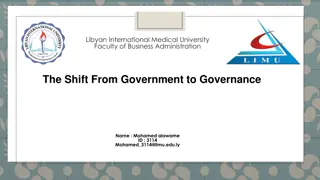Modernizing Budgeting Practices for Better Governance
Embracing a shift from traditional budgeting methods, the update emphasizes results-driven funding decisions, increased transparency, and accountability through outcome-based measurements and performance evaluations. The reform fosters efficiency, prioritizes citizen-centric outcomes, and ensures responsible resource allocation. By challenging legacy practices, the framework encourages strategic spending aligned with community needs and promotes fiscal prudence.
Download Presentation

Please find below an Image/Link to download the presentation.
The content on the website is provided AS IS for your information and personal use only. It may not be sold, licensed, or shared on other websites without obtaining consent from the author. Download presentation by click this link. If you encounter any issues during the download, it is possible that the publisher has removed the file from their server.
E N D
Presentation Transcript
The Old Budget Game Cost- Based Budgeting Starting Point Last Year = BASE costs Focus Addition Add/ Subtract costs re: BASE Autopilot increases = new BASE Plus needs Subtraction Submission Cut from new BASE Justification for needs/costs -- plus a little extra
The Old Game (contd) Incentives Analyst s job Elected s job Build up costs - make cuts hard Find hidden/ unnecessary costs Choose to cut services, OR Raise taxes to cover costs GET BLAMED! Focus of debate What to cut What to tax Avoiding pain before next election What drives decisions?
In with the New Funding for all state agencies, boards and commissions will be kept, cut or eliminated based on their capacity to deliver measurable results. No more automatic funding.
Spending Reform Laws Senate Bill 3660 Requires agencies to establish outcomes and performance based measurements; multi- year revenue forecasts Senate Bill 3708 Taxpayers get access to quarterly budget Statements: Actual vs. Budgeted Results BUDGETING FOR RESULTS House Bill 5424 Mandates realistic revenue number in establishing state budget ; deduct fixed costs
RESULTS You can spend my money on programs, I just want to see efficiency and I want to see results. ---Rich, 80
Budgeting for Results Asks Four Basic Questions How much revenue will we have? What outcomes matter most to our citizens? How much should we spend to achieve each outcome? How can we BEST deliver each outcome that citizens expect?
1. Decide How Much to Spend Governor Quinn introduced his budget. His budget for FY 12 projected to spend $35.98 billion in General Revenue. The following slide is a pie chart breakdown of that budget as introduced.
Governor Quinn's Proposed FY 2012 GRF Operating Expenditures and Transfers Out $35,978 Billion4 Statutory Transfers Out 6.4% Operation of State Governemnt -12.2% Government Services 7.7% Debt Service 7.1% Public Safety and Regulation 4.5% Pensions 12.2% Human Services 14.9% Government Services - $2,757.6 Public Safety and Regulation - $1,622.5 Human Services - $5,365.3 Medicaid/Healthcare - $7,592.8 Medicaid/Healtcare 21.1% P-20 Education 26.1% Education - $9,393.8 Pensions - $4,389.6 Debt Service - $2,540.0 Statutory Transfers Out - $2,317.2
How Much to Spend? But Budgeting for Results asks the question: How much money do we have to spend at the time of the budget as introduced? This year, the Senate estimated $34,282 billion; The House estimated $33,173.5 billion. It was historic because the budget process typically starts with costs, not with revenue.
SJR29 FY12 Projected General Revenue Fund by Source $34,282 Million Federal Receipts 14.1% Other Taxes and Fees 13.8% Individual Income Tax 46.0% Individual Income Tax - $15.8 Corporate Income Tax - $2.2 Sales Tax - $6.7 Other Taxes and Fees - $4.7 Federal Receipts - $4.8 Sales Tax 19.7% Corporate Income Tax 6.3%
Spending Pressures (in millions) $4,200 $4,500 $4,000 $3,500 $3,000 $2,422 $2,170$2,061$2,136 $2,500 $2,000 FY11 FY12 $1,436 $1,340 $1,500 $1,000 $696 $500 $0 $0 $0 Total Group Health Loss of Federal Funds Pension Contribution Debt Service Transfers Out
FY 2012 GRF Operating Expenditures and Transfers Out $33,291 Million Operation of State Governemnt: 8.1% Statutory Transfers Out 6.1% Government Services 3.4% Debt Service 6.5% Public Safety and Regulation 4.7% Pensions 12.6% Human Services 15.4% Government Services - $1,141.3 Public Safety and Regulation - $1,578.9 Human Services - $5,137.4 Higher Education 6.3% Medicaid/Healthcare - $8,200.7 Medicaid/Healthcare 24.6% P-12 Education - $6.750.4 Higher Ed - $2,092.4 P-12 Education 20.3% Pensions - $4,200.0 Debt Service - $2,170.0 Statutory Transfers Out - $2,020.5
Summary of State of Illinois Spending FY 05- FY 12 (In Billions) $ in billions GRF OSF FF Subtotal Bonded Pensions TOTAL FY05 $26.2 $16.8 $5.8 $48.8 FY06 $27.2 $13.2 $5.7 $46.1 FY07 $28.5 $17.0 $5.8 $51.3 FY08 $30.4 $13.6 $5.0 $49.0 FY09 $33.0 $15.1 $5.9 $54.0 FY10 $28.7 $20.5 $9.9 $59.1 FY11 $31.1 $20.8 $10.2 $62.1 FY12 $33.1 $16.8 $8.9 $58.9 $3.4 $62.5 $3.7 $65.8 $48.8 $46.1 $51.3 $49.0 $54.0 $58.9
2. Set the Priorities of Government: The Results Citizens Desire Ask citizens: Door to Door Surveys Focus groups Internet surveys We have set up a commission. This input creates legitimacy for the process. Through this input, legislators and leaders make final decision.
IL Priorities of Government Results Providing a quality education and opportunities for growth. Growing the jobs of today while working to create the global industries of tomorrow. Protecting businesses and residents from crime, catastrophe and wrongdoing. Protecting our children, veterans, poor, disabled, elderly and sick. Making government more efficient and effective. Maintaining our cultural and natural resources.
3. Pricing the Priorities How Much Should You Spend on Each? How much are they each worth? Not how much do they cost? BFR Commission makes recommendations, can be adjusted later in the process--serves to create a finite pot of money for each outcome goal. Last year, the House and Senate differed in their approach to adopting revenue and making appropriations.
IL Priorities of Government Results Providing a quality education and opportunities for growth. Growing the jobs of today while working to create the global industries of tomorrow. Protecting businesses and residents from crime, catastrophe and wrongdoing. Protecting our children, veterans, poor, disabled, elderly and sick. Making government more efficient and effective. Maintaining our cultural and natural resources.
Jobs Note: General Revenue Fund Budget does not include $13 billion in bonded capital projects that are distributed and overseen through DCEO, IDOT and Capital Development Board.
4. Monitor Performance and Evaluate Outcomes Budget Director David Vaught sends letter to agency directors requiring answers to these questions: Which prioritized budget outcome will your agency meet? How will you achieve your desired outcomes? How much will your agency services cost GRF, OSF and Federal Funds? How will your measure results? And what achievement targets can you commit to?
Appropriations Committee Every state agency received a letter from the Appropriations Chairs asking: What are the outcomes your agency is attempting to achieve? What are the measurable results of these outcomes? What is the value of the outcomes? What outcomes have been achieved in the past? How does the agency plan to improve the value of services it provides?
Example: IL Human Services Division of Human Capital Outcomes: Assist families in attaining economic stability. Improve health and alleviate food insecurity. Provide shelter and prevent homelessness. Assist working families by providing quality child care. Facilitate immigrant integration and attained citizenship.
IL Human Services Division of Human Capital Performance Measures (historical): 46% of homeless adults and children were placed in permanent of transitional housing upon leaving the shelter. 72% of persons leaving supportive housing attained independent living. 88% of all households that received homeless prevention assistance maintained their housing.
IL Human Services Division of Human Capital Value: 2.5 billion in benefits to families (temporary assistance) generated $4.6 billion in economic activity. $1 million prevents homelessness in 2,500 households. Every $1 dollar invested in child case saves taxpayers $13 in future costs.
Strategies Focus on homeless prevention: reduces demand for other services crisis intervention, relocation assistance, etc. Focus on supportive housing for formerly homeless persons: results in decreases in in- patient psychiatric care, county jail interactions, uncompensated hospital care. Focus on increasing the number of children cared for in a licensed setting: leads to fewer children in special education, fewer welfare payments.
Performance Based Funding What matters most? Requests for Results take the place of Budget Instructions. A specific level of performance at a specific price. Proposed measures of performance No guarantee of funding based on historic levels. Opportunities for departments to propose new, innovative practices.
Innovative Offers: Examples Iowa: Reinvented the Corrections Department, to drive down recidivism Washington State: Moved $45 million from ER care to drug and alcohol treatment under Medicaid Illinois is working on unified budgeting in the area of long-term care for seniors and the developmentally disabled.
The Bottom Line Focus on the keeps, not just the cuts Buy results, not costs Low-value spending is forced out of the budget Important new investments go to the front of the queue General interest trumps special interests Performance accountability Continuous reform/improvement Common Sense communications


























